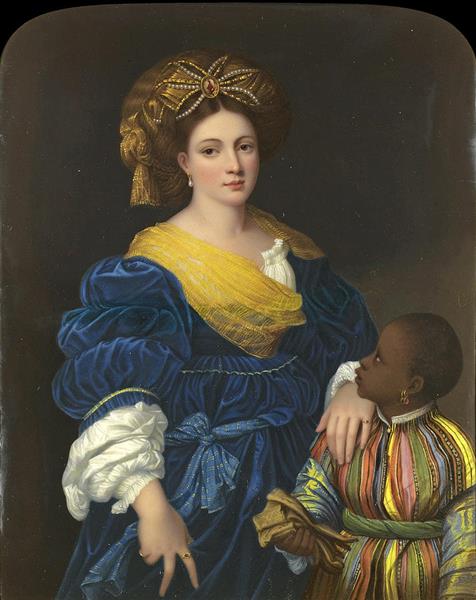Beschrijving
Titian, one of the masters of the Venetian Renaissance, left an indelible mark on art through portraits such as that of Laura de Dianti, painted in 1523. This work stands out not only for its technical prowess, but also for its ability to capture the psychological essence and beauty of its subjects. Laura de Dianti, the woman portrayed, appears with a serene elegance that is combined with a powerful presence that transcends the canvas. The painting exhibits a play of light and shadow that enhances the three-dimensionality of Laura's face, demonstrating Titian's deep understanding of the human form and expression.
The portrait is characterised by its vertical composition, where Laura occupies almost the entire work, drawing the viewer’s gaze to her face and clothing. The delicacy of her features is accentuated by the masterful use of colour, where warm tones predominate on the face and the neutral background highlights her figure. The eyes, which seem to have a life of their own, are a testament to Titian’s talent for conveying subtle emotions; her gaze is intense and charged with an air of mystery that invites contemplation. The choice of a rich but subdued palette, with touches of red and gold in Laura’s clothing, reinforces her status and grace, while her dark hair and fair skin create a contrast that adds depth to the image.
A notable aspect of the work is the attention to detail in the textiles. The quality of the fabric enveloping Laura, with its fluid folds and texture, suggests not only her material wealth, but also a symbolism of her position in Venetian society at the time. Titian, known for his skill with textures and nuances, here demonstrates his mastery by capturing the softness of human skin and the opulence of fabrics with loose brushstrokes that bring the surface to life.
It is also interesting to reflect on the context in which this work was created. During the Renaissance, portrait painting was not only about depicting physical appearance, but also about affirming the social status and individuality of the subject. Laura de Dianti is not only an aesthetic figure, but represents the ideal of beauty of her time, embodying the values of sophistication and culture that flourished in Venice.
Although not many details are known about her life, Laura de Dianti is mentioned in art history as the artist's muse, which adds a layer of intimacy to the work. The fact that Titian chose to portray her with such care suggests a personal connection, she being more than just a model, a representation of an ideal of love and admiration.
Titian's work is part of a tradition of portraits of women of his time, but is particularly notable for its profound realism and its ability to convey the personality of the subject. Like other contemporary portraits, such as those of Parmigianino or Raphael, Dianti's depiction of Laura enters a field where the aesthetics and psychology of the sitter are intertwined, and the viewer can feel the presence of the character beyond the painting.
Thus, Dianti's Portrait of Laura not only stands as a masterpiece of Renaissance painting, but also invites the viewer to explore the complexity of what is revealed and what remains hidden in the woman's gaze. Titian, through this piece, remains in conversation with us, whispering from a past that lives on in art.
KUADROS ©, a famous painting on your wall.
Hand-made oil painting reproductions, with the quality of professional artists and the distinctive seal of KUADROS ©.
Painting reproduction service with satisfaction guarantee. If you are not completely satisfied with the replica of your painting, we will refund 100% of your money.

